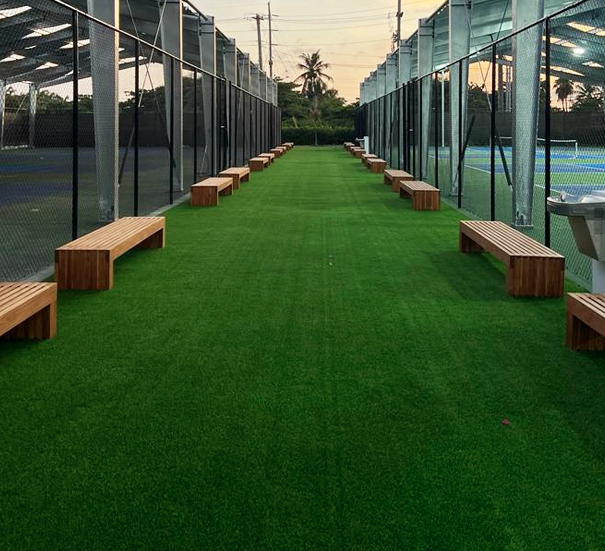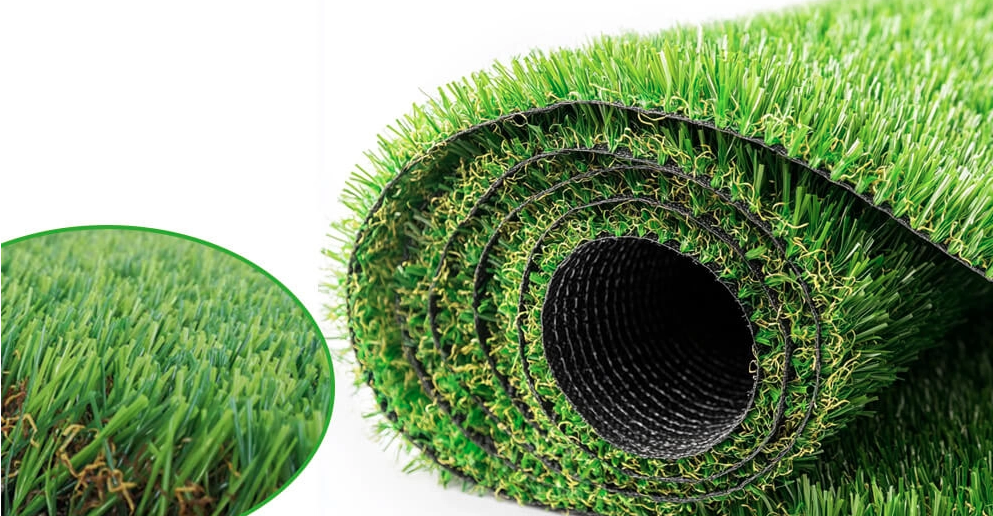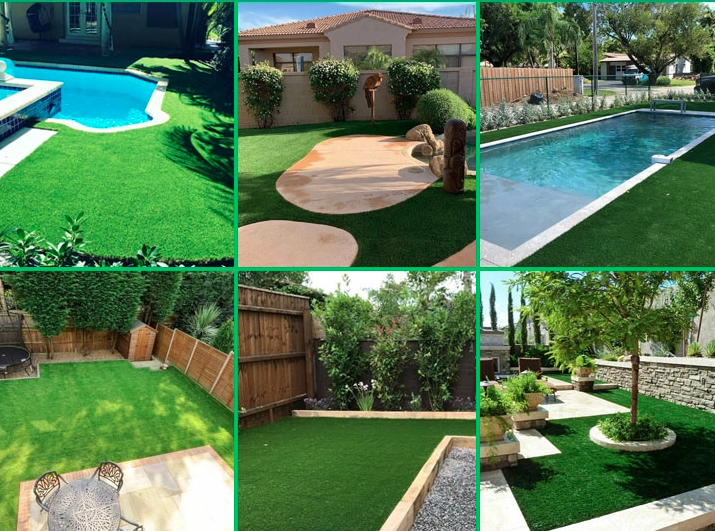
Artificial grass has become a popular choice for homeowners seeking a low-maintenance, lush lawn, but many wonder, is artificial grass waterproof and how it handles rain or moisture. In this guide, we explore how synthetic turf manages water, prevents mold, and stays green even in wet conditions. You’ll learn about built-in drainage systems, fiber durability, and tips for keeping your lawn safe and functional. Whether for pets, kids, or sports, discover how artificial grass offers a resilient, water-resistant alternative to natural lawns.
What Waterproof Means for Artificial Grass
When we say artificial grass is waterproof, it means water passes through the surface without harming fibers or backing. Unlike natural grass, which absorbs water and becomes muddy, synthetic turf resists rot and mold.
Artificial grass fibers are usually made from:
Polyethylene (PE): Strong, durable, and resistant to wear. Commonly used in lawns and playgrounds.
Polypropylene (PP): Softer and more flexible, gives a natural feel underfoot.
Polyurethane: Adds extra safety, highly resistant to UV rays, chemicals, and weathering.
This combination of materials ensures the turf stays vibrant and functional even after prolonged exposure to moisture, making it suitable for heavy rain or humid climates.
How Artificial Grass Handles Water
Built-in Drainage Systems
Artificial grass doesn’t just repel water—it channels it safely away. Most turf comes with perforated backing, tiny holes hidden in the grass fibers. Water flows through these holes into the base layer beneath. Some high-drain products even feature 100% permeable backing, ideal for pet areas or zones with frequent water exposure.
Typical turf layers for proper drainage:
Top layer: Synthetic grass fibers
Perforated backing: Channels water into sub-base
Sub-base: Crushed limestone or gravel for stability and drainage
Fine layer: Grano dust or sand to level surface
This system prevents puddles and ensures the lawn is usable almost immediately after rain or sprinkler use.
Water Penetration and Flow
Water behaves differently on artificial turf than on soil. Here’s what happens:
Rain hits the fibers.
Water passes through holes in the backing.
It drains into the gravel or limestone base.
Excess water moves into the soil or drainage pipes.
Compared to natural grass, artificial turf drains faster, avoids mud, and doesn’t get compacted. Even heavy storms are less likely to make your yard unusable.
Waterlogging and Extreme Conditions
Artificial grass can handle flooding or heavy rain, but certain infill types might float slightly during extreme storms. High-quality infill materials, like silica sand or rubber granules, stay in place and maintain turf performance.
For snow or ice:
Light snow can be brushed away.
Heavy snow should be removed layer by layer, leaving a small protective layer.
Avoid salt or chemicals—they can clog drainage holes and reduce turf performance.
Proper sub-base design and drainage planning are crucial for areas with heavy rainfall or seasonal flooding.
![Soft Artificial Turf Grass Roll Soft Artificial Turf Grass Roll]()
Does Rain or Water Damage Artificial Grass?
Artificial grass is designed to handle all types of weather, making it a long-lasting solution for homes, playgrounds, and sports fields. Its resilience comes from high-quality synthetic fibers, specialized backing, and engineered drainage systems.
Water Resistance of Fibers
The synthetic fibers used in artificial grass—typically polyethylene (PE), polypropylene (PP), or polyurethane (PU)—are inherently water-repellent. This prevents water from being absorbed into the blades, stopping issues like rot, mildew, or mold that often occur in natural grass. Even after heavy rain, the fibers retain their color, softness, and structural integrity, ensuring a lawn that looks and feels healthy.
Protection Against Environmental Factors
In addition to rain, artificial grass is exposed to sun, heat, and seasonal changes. UV stabilizers in the fibers prevent fading and degradation from sunlight, while the synthetic materials remain strong in cold or humid conditions. Unlike natural grass, the turf won’t yellow, lose strength, or develop fungal patches after wet weather, snow, or ice.
Safety and Usability After Rain
Because artificial turf drains quickly and doesn’t retain mud, it remains safe for children, pets, and sports activities. Wet natural lawns often become slippery, messy, and unusable for hours, whereas synthetic turf maintains a flat, cushioned, and non-slip surface. Homeowners also benefit from reduced indoor mess, as muddy footprints are no longer an issue.
Long-Term Durability
Thanks to its water resistance, engineered drainage, and UV protection, artificial grass can withstand prolonged exposure to rain and wet conditions for years without significant wear. Proper installation and maintenance, including checking drainage holes and brushing fibers after heavy rainfall, help extend the turf’s lifespan, often reaching 8–15 years.
Managing Artificial Grass in Wet Weather
Artificial grass is designed to be durable and water-resistant, but even the best synthetic turf benefits from regular care, especially after rain, snow, or prolonged moisture exposure. Proper maintenance ensures the lawn remains green, safe, and functional, and it helps extend the lifespan of the turf.
Cleaning and Maintenance
Even though artificial turf repels water, debris such as leaves, twigs, or small branches can accumulate on the surface. If left unchecked, this material can block drainage holes, trap moisture, and gradually wear down the fibers. To maintain a clean, healthy lawn, homeowners can use a leaf blower or broom to remove surface debris and keep the turf tidy. For deeper cleaning, a low-pressure power washer works well to rinse dust or dirt without damaging the fibers. Stains or spots can be treated with a mild detergent, applied carefully and rinsed thoroughly. Regular brushing of the turf fibers not only lifts flattened areas but also helps redistribute infill, keeping the surface even and preventing clumping. By following these simple routines, the turf can drain water efficiently after rainfall and remain free of bacteria or unpleasant odors.
Moisture and Mold Prevention
Shaded or poorly ventilated areas tend to retain moisture, increasing the risk of mold or mildew growth. To prevent this, it’s important to inspect the drainage system regularly and ensure all perforations in the backing are unobstructed. After rain, artificial turf should dry completely, particularly in spots that receive little sunlight. If moisture persists, applying a mild anti-fungal treatment can further protect the lawn. Homeowners should avoid leaving standing water or debris on the turf for long periods, as this can encourage mold growth and degrade infill materials over time. Maintaining airflow and sunlight exposure in these areas will help the lawn stay healthy, even in damp or humid conditions.
Snow and Ice Handling
Artificial turf performs much better than natural grass during winter. While natural lawns can turn brown, become muddy, or freeze solid, synthetic turf remains usable and visually appealing. For light snow, a simple broom can be used to brush it away, preventing compaction of the fibers. In cases of heavy snowfall, it’s best to shovel the snow in layers, leaving a small protective layer on top to avoid damaging the turf beneath. Once the snow melts, brushing the flattened fibers restores the lawn’s natural upright appearance and prevents clumping. It’s important to avoid using rock salt or harsh chemicals, as these substances can damage the backing, clog drainage holes, and reduce the turf’s ability to shed water efficiently. By following these practices, artificial grass can stay safe, functional, and attractive throughout the winter months.
Artificial Grass vs Natural Grass in Wet Conditions
| Feature | Artificial Grass | Natural Grass |
| Drainage | Fast, built-in holes and layers | Slow, soil dependent |
| Mud and mess | None, usable immediately | Muddy, delays use |
| Appearance | Always green | Seasonal, may yellow or patchy |
| Maintenance | Low: no mowing, watering, fertilizer | High: watering, mowing, fertilizing |
| Safety | Flat, consistent, cushioned | Uneven, muddy, slippery |
Artificial grass offers a clean, dry surface even after storms. Kids and pets don’t track mud indoors, and athletes can play almost immediately.
Safety Concerns When Artificial Grass Gets Wet
While artificial grass is designed to handle moisture, certain infill materials can become slightly slippery when wet. This can pose a risk, especially in playgrounds, sports areas, or high-traffic zones. Choosing the right infill is essential. Materials with good traction help maintain grip for children, pets, and athletes. Areas with an uneven sub-base can increase the risk of slips or trips, so proper installation is critical to ensure a flat, consistent surface.
Cushioning and Surface Safety
One advantage of artificial turf is that its fibers provide a soft, cushioned surface. This slight cushioning reduces impact on joints during running or playing, making it safer than hard surfaces such as concrete or asphalt. Non-infill systems are another option for playgrounds or areas with heavy foot traffic, as they reduce the chance of slipping while maintaining a consistent texture.
Consistent Surface and Drainage
Proper drainage and a uniform sub-base are key to safety during wet conditions. Artificial grass installed with perforated backing and a well-prepared drainage layer ensures water doesn’t pool on the surface. A consistent, dry surface reduces the likelihood of accidents and allows play areas to remain usable even after heavy rainfall.
Longevity and Durability of Artificial Grass
Artificial grass is built to last, often remaining functional and attractive for 8 to 15 years with proper care. The lifespan depends on several factors, including fiber quality, installation, and maintenance routines.
Fiber Quality
High-quality fibers, usually polyethylene (PE) or polypropylene (PP), are resistant to wear and environmental damage. These fibers maintain their strength, color, and flexibility even under frequent use or exposure to harsh weather, ensuring a long-lasting lawn that retains its appearance.
Installation Quality
A well-prepared sub-base is essential for durability. Leveling the ground, using perforated drainage systems, and evenly laying the turf prevents water accumulation, reduces fiber compression, and maintains structural integrity. Poor installation can cause uneven surfaces, reduce drainage efficiency, and shorten the turf’s effective lifespan.
Maintenance and Upkeep
Routine cleaning, brushing fibers, and replenishing infill help preserve both the appearance and functionality of artificial grass. These simple actions prevent compaction, distribute moisture evenly, and reduce wear on high-traffic areas. Regular inspections of drainage holes and the sub-base also prevent long-term issues such as odors or mold growth.
Warranties
Most artificial turf products come with warranties of 8 to 10 years, covering defects in materials or workmanship. It’s important to note that warranties usually do not cover poor installation, neglect, or misuse, so following maintenance guidelines is key to maximizing lifespan.
![Grass Roll Grass Roll]()
Strategies for Heavy Rainfall
Effective Drainage Planning
Perforated pipes beneath turf move water away quickly
Slight slope ensures water flows to drains
Water-resistant underlayment reduces absorption
Clear drainage pipes regularly for best performance
Post-Rain Recovery
Remove puddles using squeegee or hose
Brush fibers to redistribute infill
Air and sunlight speed drying
Optional: tarp coverings during storms minimize water contact
FAQ
Q1: Is artificial grass completely waterproof?
Yes, artificial grass is waterproof because its synthetic fibers repel water and the backing prevents moisture absorption, keeping the lawn functional even after rain.
Q2: Can artificial grass get wet?
Yes, artificial grass can get wet. Its perforated backing and drainage system allow water to pass through without damaging fibers or sub-base.
Q3: Does rain damage artificial grass?
No, artificial grass resists rain, UV rays, and extreme weather. It does not rot, fade, or develop mold, maintaining a lush appearance year-round.
Q4: How does artificial grass drain water?
Water drains through tiny holes in the backing into a sub-base made of gravel or crushed limestone, which directs excess water into the soil or drainage pipes.
Q5: Can artificial grass survive heavy rainfall or flooding?
Yes, high-quality artificial grass handles heavy rain or temporary waterlogging, though some infill types may shift slightly during extreme storms. Proper drainage and infill selection prevent performance issues.
Conclusion
Artificial grass keeps your lawn looking great, even when rain pours or sprinklers run. Its clever drainage system channels water efficiently, while durable fibers stay soft, green, and resilient through all weather. Kids, pets, and sports enthusiasts can enjoy the yard immediately without mud or slippery patches.
For a long-lasting, low-maintenance outdoor space, Qingdao XiHY Artificial Grass Company offers expertly designed synthetic turf built to resist moisture, prevent mold, and stay safe year-round. With proper installation and care, your lawn stays vibrant, clean, and ready for action every day.













